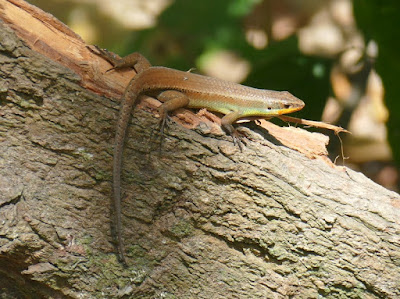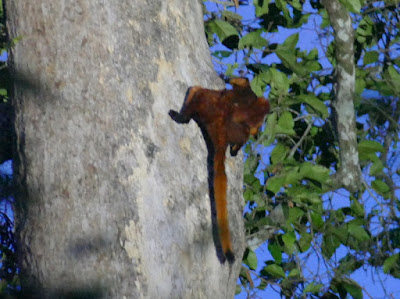Last time I introduced the Sepilok area in eastern Sabah, Malaysian Bornea. With this post I'm continuing that series, but with a fairly brief post, relating to the surrounds of the Rainforest Discovery Centre, which is immediately adjacent to the Orang Utan and Sun Bear rehabilitation centres.
This is primarily a schools education centre, but the public are welcome. It comprises an excellent interpretive centre and walking tracks through both labelled plantings of rainforest species and primary rainforest. One such walk circles a lake and climbs, via a boardwalk, to a canopy-level viewing tower. Flowering plants around the carpark support a good population of sunbirds. My photos on the whole were disappointing, and some are really not usable, but rather than ignoring the centre I've opted for this short photo essay, covering at least three visits there over two years.
The forest itself is superb, especially as experienced from the boardwalk and viewing tower. Here are some views of it.
 |
| I really can't get enough of tropical rainforest! |
The dipterocarps are members of the family Dipterocarpaceae, nearly 600 species of rainforest trees found throughout the tropical forests South America, Africa and Asia, but Borneo is their hotspot. There, you have a very good chance of getting it right by identifying a rainforest tree as a dipterocarp!
 |
| Parashorea sp., Dipterocarpaceae, Rainforest Discovery Centre. |
Obviously there are birds present, but as is often the way in rainforests it is not always easy to photograph them. (Still less easy to do so well, though I'd like to be able to have my time there over with my current camera.)
 |
| Grey-cheeked Bulbul Alophoixus tephrogenys (at least I'm almost sure of the species, though a bit more light would have been good). I do tend to have trouble with bulbuls I'm afraid. |
 |
| Female Orange-backed Woodpecker Reinwardtipicus validus. This is a fairly big woodpecker, and the only one of its genus. He is more colourful. |
 |
| Eastern Crimson Sunbird Aethopyga siparaja. I almost left this photo out, but he is very handsome... |
Lower down are reptiles.
 |
| Skink Mabuya (or Eutropis) multifasciata. |
 |
| Malayan Box Terrapin Cuora amboinensis. |
But perhaps the most impressive animal we saw there was a mammal, for which we waited until near dark. The following photos give the impression of more light than was actually present - I used a very high ISO and balanced the camera on the boardwalk railing for a very slow shot in torch light. I'd never seen any of the 'flying' squirrels previously, and this one was magnificent. Our guides knew their day-roost hollow, so we just waited for them to emerge.
 |
| Giant Red Flying Squirrel Petaurista petaurista.The 'giant' part of the name is not used lightly; head and body are over 40cm long and the tail longer still. |
 |
| Giant Red Flying Squirrel against the moon. |
After a few minutes it turned towards us and glided directly overhead into the forest, at least 100 metres in the air. It was an impressive finale.
I'll be back next time to complete this celebration of the wildlife of Sepilok.
 |
| Sunset over the forest, Rainforest Disovery Centre, Sepilok. |
NEXT POSTING THURSDAY
(And
remember that you can get a reminder when the next post appears by
putting your email address in the Follow by Email box in the top right
of this screen.
And I'd love to receive your comments - it's easy and you don't need to sign in!)
And I'd love to receive your comments - it's easy and you don't need to sign in!)






No comments:
Post a Comment